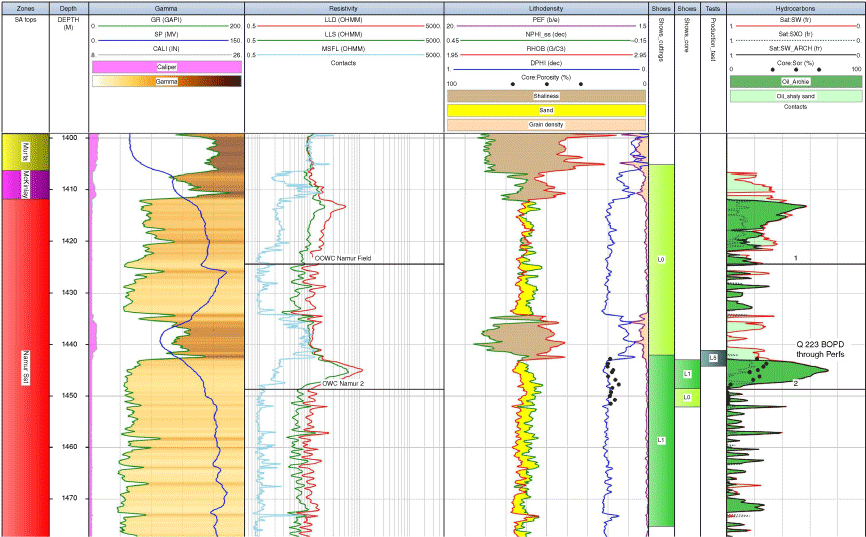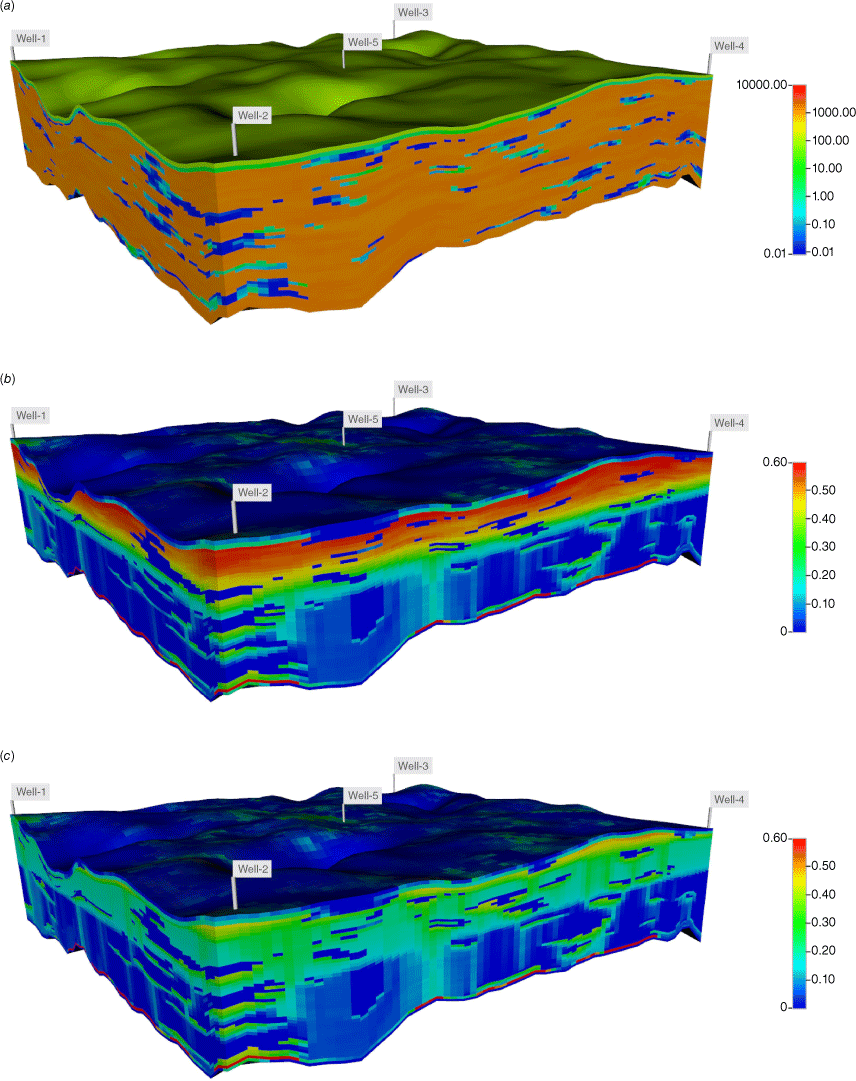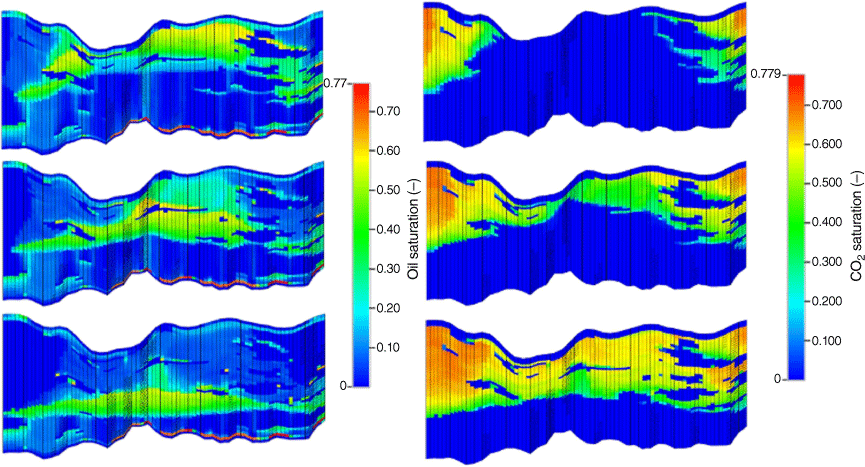The potential for CO2 storage in residual oil zones in onshore Australian basins
Aleksandra Kalinowski A * , Eric Tenthorey A , M. Ben Clennell B , Mojtaba Seyyedi C , Richard Kempton B , Samuel Jackson B , Claire Patterson A and Siyumini Perera BA
B
C

Aleks Kalinowski is Assistant Director of Low Carbon Geoscience and Advice at Geoscience Australia and holds a PhD from the University of New South Wales. Aleks has worked extensively on CCS and continues to focus on CCUS, hydrogen and other low carbon technologies and resources. |

Eric Tenthorey is a senior researcher at Geoscience Australia, with expertise in geomechanics, CCUS and other low carbon geoscience disciplines. He holds a PhD from Columbia University and worked as a researcher at the Australian National University. His current work includes low carbon geoscience sectors such as the hydrogen energy future, geothermal energy, and CO2-EOR. |

Ben Clennell is a Senior Principal Research Scientist at CSIRO Energy and leads the Geodata Analytics Research team. He holds a PhD in Geology from the University of London. His research focusses on rock physical properties applied to petroleum geoscience, hazard reduction and CO2 storage, and the fluid flow properties and petrophysical characterisation of reservoir, seal and fault rocks and developing automated methods for subsurface characterisation. |

Mojtaba Seyyedi is a reservoir engineer specialising in CO2 utilisation/EOR and storage with over 10 years of international experience consulting for the world’s leading Oil & Gas companies. Mojtaba has led and contributed to multiple major CO2-EOR and/or storage projects in the Middle East, UK, Denmark, Canada, Malaysia, Brazil, and Australia. He obtained his PhD from Heriot-Watt University. |

Richard Kempton holds a PhD in geology from the University of Western Australia. Richard is a senior research scientist with the Geofluids Team at CSIRO Energy in Perth and has 20+ years’ experience in petroleum systems analysis using fluid inclusions to reconstruct charge histories. Prior to joining CSIRO, Richard worked for Queensland Gas Company. |

Samuel Jackson is a Senior Research Scientist at CSIRO Energy. He has a PhD in Mechanical Engineering from the University of Nottingham and was a postdoctoral research associate at Imperial College London. He has over 10 years of international research experience in multiphase flow modelling and experiments, related to carbon and hydrogen underground storage. |

Claire Patterson is a geoscientist in the Low Carbon Geoscience and Advice team at Geoscience Australia working across CCUS, hydrogen and other low emissions technologies. Claire holds a Bachelor of Advanced Science (hons) from the Australian National University. |

Siyumini Perera holds a PhD in biostratigraphy and microfossil imaging from the University of Queensland. She joined the Geofluids Team at CSIRO in 2023 as a research technician applying fluid inclusions to the characterisation of geofluids within sedimentary basins. |
Abstract
Geoscience Australia and CSIRO have collaborated to investigate whether residual oil zones (ROZs), sometimes associated with conventional Australian hydrocarbon plays, could provide a carbon dioxide (CO2) storage resource and enhance the storage capacity of depleted fields. Our petrophysical study demonstrates that ROZs occur in Australia’s hydrocarbon-rich regions, particularly in the Cooper-Eromanga Basin. ROZs with more than 10% residual oil saturation are uncommon, likely due to small original oil columns and lower residual saturations retained in sandstone reservoirs than in classic, carbonate-hosted North American ROZs. Extensive, reservoir-quality rock is found below the deepest occurring conventional oil in many of the fields in the Eromanga Basin, potentially offering significant CO2 storage capacity. Multiphase compositional flow modelling was used to estimate the CO2 storage efficiency of typical Australian ROZs. We developed a novel modelling methodology that first captures oil migration events leading to the formation of ROZs. Modelling CO2 storage over a 20-year injection period demonstrates that CO2-oil interactions increase the density and viscosity of CO2, enhancing CO2 sweep efficiency and lateral flow, improving storage efficiency. The extent of these effects depends on the quantity and spatial distribution of residual oil in place and the miscibility of CO2 at reservoir conditions.
Keywords: CO2 storage, Cooper Basin, Eromanga Basin, Exploring for the Future, multiphase compositional flow modelling, petrophysical analysis, residual oil zone.
Introduction
Depleted hydrocarbon fields and deep saline aquifers are the main targets for geological storage of carbon dioxide (CO2). Residual oil zones (ROZs) potentially combine the benefits of utilising depleted fields – including existing knowledge, operational experience, potentially reusable infrastructure and accelerated permitting processes – with the larger-scale storage resource of saline aquifers.
ROZs are water-saturated reservoirs that contain immobile oil, with residual oil saturation (Sor) typically ranging from 10 to 30% (e.g. Ren and Duncan 2018), and can occur below the oil-water contact of a field or without a main pay zone (MPZ). In North America, commercial quantities of oil are being produced from ROZs through CO2-enhanced oil recovery (CO2-EOR), and the potential for additional oil production from ROZs in Australia was also investigated (Tenthorey et al. 2021; Kalinowski et al. 2022).
Through this study, we seek to understand the contribution that ROZs could make to Australia’s CO2 storage resources. We used petrophysical methods (Tenthorey et al. 2022) to identify and characterise ROZs in the Cooper-Eromanga, Bowen-Surat, Amadeus, and Simpson-Pedirka-western Eromanga basin regions and coupled this with dynamic modelling of an Australian-style ROZ to better understand the CO2 storage efficiency of these reservoirs.
The occurrence of ROZs in Australian basins
Several ROZs were identified in the Cooper-Eromanga Basin, while isolated examples were found in the Pedirka and Bowen basins. No ROZs were found in the Amadeus Basin.
We identified two types of ROZs in the Jurassic sandstone reservoirs of the Eromanga Basin. In the first type, found in certain McKinlay/Namur reservoirs and Birkhead/Hutton Reservoirs, the oil below the MPZ occurs in an apparently thickened transition zone a few metres in extent, with Sor between 10 and 25%. This type of ROZ has a very similar appearance to residual oil left after production from a field with basal aquifer support, but as we found examples in wells drilled prior to oil production, they are ascribed a geological origin. These thick ROZs are always accompanied by distinct oil shows.
The second type is more commonly encountered in Namur Sandstone and Hutton Sandstone reservoirs. The oil extends for 20 m or more below the MPZ with Sor ranging from ~0 to 10%. These ‘ragged’ ROZs have Sor close to the limit of detection using petrophysical methods and must be verified by oil shows, which are usually at trace level and may be discontinuous. Rarely have ROZs been investigated to quantify the residual oil distribution using advanced logging tools and specific sampling (the Gidgealpa Field is one example).
The low and variable Sor interpreted in the ‘ragged’ ROZ type is confirmed by Special Core Analysis (SCAL) measurements that were extracted from a variety of well completion reports, spanning decades. Most of the Sor values that we compiled range from a few percent to ~13%. The rock type and mineralogy – fluvial sandstones rich in quartz, with clays commonly dominated by kaolinite – appear to have pore types and surface wetting characteristics that inherently do not trap large amounts of oil. Moreover, the oil is light (typically 50 API), quite volatile and highly mobile, so it is lost from the pore space more easily than heavier oil.
An example of residual oil below the main oil column in the Namur Sandstone reservoir of the Strzelecki field is shown in Fig. 1. Clean sand (Archie) and shaly sand (Indonesia) petrophysical models suggest the widespread presence of oil at Sor of 0–10% (below where it becomes mobile). This low and patchy distribution of oil saturation is quite typical of the ROZs that we encountered in several Australian fields.
Petrophysical log plot showing the distribution of oil in the Namur Sandstone reservoir in well Strzelecki 23, Cooper-Eromanga Basin, South Australia. There are two distinct oil columns: the first extending up into the McKinlay Member shaly sandstones and down to the field-wide oil-water contact (spill point); the second pooled beneath a shale break at Mid-Namur level. Oil at residual levels is distributed below both columns, nearly throughout the entire Namur Sandstone reservoir, evidenced by moderate to strong oil shows and petrophysical indicators. Core data was used to calibrate the log of density porosity (DPHI) and extracted residual oil distribution (Sor), which drops to near-zero below the lower column, where a second oil-water contact was identified.

The tendency for low Sor, regardless of the thickness of the ROZ, means that most Australian ROZs (the ‘ragged’ type) are not prolific or attractive economic targets for CO2-EOR in comparison with examples from North America. Note that these ‘classic North American ROZs’ are mostly hosted in carbonate reservoirs, often contain heavy oils, are characterised by a partial or strong oil-wetting preference, and are commonly associated with distinct, ‘soured’ (containing H2S) formation waters – none of these characteristics are found in Australian ROZs.
‘Transition zone’ type ROZs could have some commercial attractiveness late in field life, because after some period of production of the main oil column, and given the generally good aquifer support, a combination of geological and engineered residual oil would be merged together in a high structural position with an expected Sor in the 20–25% range. The economics would depend on the amount of residual, missed and bypassed oil that could be swept by injected CO2.
Multiphase compositional flow modelling
Multiphase compositional flow modelling (CMG-GEM) was used to estimate the CO2 storage efficiency of typical Australian ROZs. As correct initialisation of the model is essential for achieving a realistic distribution and quantity of residual oil in place, we developed a novel modelling methodology that captures oil migration events leading to the formation of ROZs.
Typical geological conditions derived from the Cooper-Eromanga Basin were used to construct a ‘representative Australian ROZ’ model. The static model’s dimensions are 2 km × 2 km × 103 m of sediment thickness, over a depth range of 1741–1845 m. The 300,800 cells have an average size of 25 m (X) × 25 m (Y) × 2.2 m (Z). The facies model represents a braided fluvial system with net to gross of 90%, comprising coarse sand and shale facies.
The petrophysical model was built using sequential Gaussian simulation per facies with porosity of 2–25% and horizontal permeability of 0.01–4000 mD. The distribution of vertical permeability (assumed to be 10% of horizontal permeability) is shown in Fig. 2a.
ROZ model. (a) Permeability distribution (millidarcy); (b) oil saturation distribution by the end of primary oil migration (after 477 years); (c) oil saturation distribution by the end of aquifer encroachment (after 30 years). CO2 injection (Well 1–4) and production (Well 5) wells are marked. The vertical (Z) scale is 5× magnified compared to the horizontal (X–Y) scale.

The ROZ initialisation was done by modelling the primary migration of a specific volume of live oil from the bottom (second layer from the bottom) towards the top of the model, where oil is initially trapped by a seal (second layer from the top). After the oil column passes a critical column height, it leaks through the seal towards overlying formations (first layer from the top). Primary migration modelling was conducted until there was no further change in the spatial distribution and value of oil saturation in the model – 477 years in this case (Fig. 2b).
This unique approach honours the impact of reservoir heterogeneities on the distribution and saturation of oil in the reservoir, critical factors for oil recovery and CO2 storage potential. To ensure the entire oil column is at residual oil saturation (and not just the tail of the oil column), aquifer encroachment from the bottom towards the top of the reservoir was modelled until the system reached steady state conditions – 30 years in this case (Fig. 2c).
A five-spot pattern of four injection wells and one central production well was implemented and CO2 was injected at a rate of 1 MtCO2pa for 20 years. Note that the oil PVT (pressure-volume-temperature) properties were tuned against an actual Australian reservoir oil sample, from an eastern Australian basin, to honour the oil’s physical properties and its minimum miscibility pressure (MMP) with CO2. Reservoir pressure was chosen to be slightly higher than the MMP and the system was assumed to be isothermal (69.4°C).
Modelling CO2 storage in a ROZ over a 20-year injection period demonstrates that CO2-oil interactions increase the density and viscosity of CO2, enhancing CO2 sweep efficiency and lateral flow, thereby improving storage efficiency. The most effective scenario, which had the injectors perforated at the top and the central producing well perforated at the bottom, was able to both store the most CO2 (13 Mt) and produce the most oil (7.6% of the oil-in-place after ROZ initialisation). The CO2 sweeps and swells the oil in a fully miscible regime, producing an oil bank which displaces downwards towards the producing well (Fig. 3).
Oil saturations (left) and CO2 saturations (right) for the scenario with total flow rate 1 Mtpa injection in wells completed in the upper part of the reservoir towards a central producer in the lower part of the reservoir. The top, middle and bottom plots show fluid distributions after 1, 5 and 20 years of injection, respectively. A cross section through the central part of the model (see Fig. 2) is shown.

Conclusion
We present some of the first reported examples of Australian ROZs in publicly available literature, the most significant examples occurring in the McKinlay/Namur and Namur-Hutton reservoirs in the Cooper-Eromanga Basin with oil saturations ranging from <10 to 25%. ROZs in Australian basins are unlikely to be exploited using CO2-EOR due to their limited extent, low oil saturation and cost. These zones, however, have properties that are conducive to CO2 storage and may be excellent targets for expanding depleted field storage as they could utilise existing operations, knowledge, and infrastructure. Modelling suggests that the presence of oil in these reservoirs results in enhanced CO2 sweep efficiency and lateral flow, improving storage efficiency.
Data availability
Publications and data are available from Geoscience Australia: https://www.eftf.ga.gov.au/australias-future-energy-resources.
Acknowledgements
This study was a collaboration between Geoscience Australia and CSIRO under the Exploring for the Future program. Bridgeport Energy is thanked for providing a compositional and PVT dataset used to represent realistic oil properties in the modelling. CMG provided the software used for compositional modelling in the project under a non-commercial licensing agreement. This paper is published with the permission of the CEO, Geoscience Australia.
References
Kalinowski A, Tenthorey E, Seyyedi M, Clennell MB (2022) The search for new oil and CO2 storage resources: residual oil zones in Australia. The APPEA Journal 62, 281-293.
| Crossref | Google Scholar |
Ren B, Duncan IJ (2018) CO2 EOR and associated storage in residual oil zones: Modelling the evolution and significance of oil saturation in residual oil zones. In ‘14th Greenhouse Gas Control Technologies Conference’, 21–26 October 2018, Melbourne. (GHGT-14). 10.2139/ssrn.3365857
Tenthorey E, Taggart I, Kalinowski A, McKenna J (2021) CO2-EOR+ in Australia: achieving low-emissions oil and unlocking residual oil resources. The APPEA Journal 61, 118-131.
| Crossref | Google Scholar |
 Aleks Kalinowski is Assistant Director of Low Carbon Geoscience and Advice at Geoscience Australia and holds a PhD from the University of New South Wales. Aleks has worked extensively on CCS and continues to focus on CCUS, hydrogen and other low carbon technologies and resources. |
 Eric Tenthorey is a senior researcher at Geoscience Australia, with expertise in geomechanics, CCUS and other low carbon geoscience disciplines. He holds a PhD from Columbia University and worked as a researcher at the Australian National University. His current work includes low carbon geoscience sectors such as the hydrogen energy future, geothermal energy, and CO2-EOR. |
 Ben Clennell is a Senior Principal Research Scientist at CSIRO Energy and leads the Geodata Analytics Research team. He holds a PhD in Geology from the University of London. His research focusses on rock physical properties applied to petroleum geoscience, hazard reduction and CO2 storage, and the fluid flow properties and petrophysical characterisation of reservoir, seal and fault rocks and developing automated methods for subsurface characterisation. |
 Mojtaba Seyyedi is a reservoir engineer specialising in CO2 utilisation/EOR and storage with over 10 years of international experience consulting for the world’s leading Oil & Gas companies. Mojtaba has led and contributed to multiple major CO2-EOR and/or storage projects in the Middle East, UK, Denmark, Canada, Malaysia, Brazil, and Australia. He obtained his PhD from Heriot-Watt University. |
 Richard Kempton holds a PhD in geology from the University of Western Australia. Richard is a senior research scientist with the Geofluids Team at CSIRO Energy in Perth and has 20+ years’ experience in petroleum systems analysis using fluid inclusions to reconstruct charge histories. Prior to joining CSIRO, Richard worked for Queensland Gas Company. |
 Samuel Jackson is a Senior Research Scientist at CSIRO Energy. He has a PhD in Mechanical Engineering from the University of Nottingham and was a postdoctoral research associate at Imperial College London. He has over 10 years of international research experience in multiphase flow modelling and experiments, related to carbon and hydrogen underground storage. |
 Claire Patterson is a geoscientist in the Low Carbon Geoscience and Advice team at Geoscience Australia working across CCUS, hydrogen and other low emissions technologies. Claire holds a Bachelor of Advanced Science (hons) from the Australian National University. |
 Siyumini Perera holds a PhD in biostratigraphy and microfossil imaging from the University of Queensland. She joined the Geofluids Team at CSIRO in 2023 as a research technician applying fluid inclusions to the characterisation of geofluids within sedimentary basins. |


